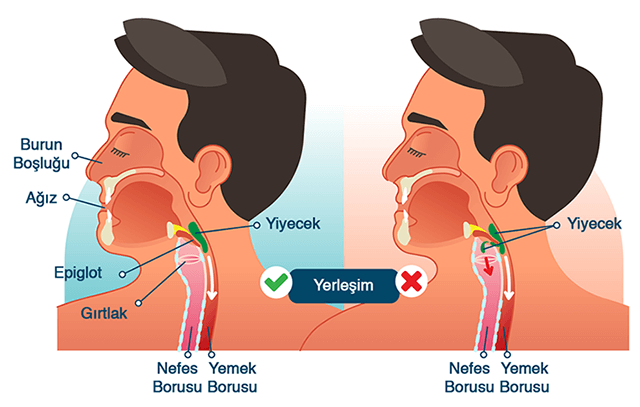Swallowing Difficulty
Difficulty in swallowing (dysphagia) is common in all age groups, especially in the elderly. The term dysphagia is the feeling of difficulty in passing food and liquids from the mouth to the stomach. This condition can be caused by many factors, most of which are non-dangerous and temporary. Difficulty swallowing rarely indicates more significant pathology such as tumor or progressive neurological disease. If the swallowing difficulty does not heal on its own in a short time, it should be evaluated by an otolaryngologist.
How is the swallowing process?
Humans swallow hundreds of times a day to eat solid foods, drink liquids, and swallow saliva and mucus produced by the body. The swallowing function has four phases:
1) The first phase is the period in which food and beverages are chewed and made ready for swallowing.
2) During the oral phase, the tongue pushes food and drink into the back of the mouth, initiating the swallowing response.
3) In the pharyngeal phase, food and beverages quickly pass from the pharynx to the esophagus.
4) In the esophagus phase, which is the last phase, food and drinks pass from the esophagus to the stomach.
The first and second phases occur under voluntary control, while the third and fourth phases occur spontaneously.
What are the Causes of Swallowing Diseases?
Any interruption during the swallowing function may cause swallowing difficulties. Difficulty in swallowing may be due to simple causes such as unhealthy teeth, unsuitable dentures or the common cold. One of the most common causes of difficulty swallowing is reflux from the stomach into the esophagus. This occurs as a result of the upward movement of stomach acid from the esophagus to the pharynx. Other causes include paralysis, progressive neurological disease, presence of a tracheostomy tube, immobile vocal cord, tumor of the mouth, larynx or esophagus, and surgical operations applied to the head and neck region.
Who Evaluates and Treats Swallowing Diseases?
If the swallowing difficulty is persistent and the cause is unknown, an otolaryngologist will take the patient's story and perform the examination.
This examination is done by examining the posterior part of the tongue, throat and larynx using mirrors or endoscopes that provide imaging with a special optical system. If necessary, examination of the esophagus, stomach and duodenum is performed by an otolaryngologist or a gastroenterologist.
As a result, it may be necessary to evaluate the swallowing mechanism functions with a barium esophageal transition film.
If special pathologies are in question, the radiologist can be contacted with upper gastrointestinal system film or videofluoroscopy. Thus, assessment of all four phases of swallowing is made. Swallowing ability can be evaluated by using different consistencies of food and drinks and giving the patient different positions. If dysphagia is due to paralysis or progressive neurological disease, it should be evaluated by a neurologist
What are the symptoms?
1. Increased saliva in the mouth
2. Feeling of food and drink getting stuck in the throat
3. Discomfort in the throat and chest (if there is an escape from the stomach to the esophagus - Reflux)
4. Feeling of foreign body or part in the throat
5. Malnutrition and weight loss due to prolonged or significant dysphagia
6. Coughing and choking sensation due to food particles that do not pass easily during swallowing, liquid and saliva, and their aspiration into the lungs
What are the possible treatments?
If the cause has been identified, dysphagia can be treated with medical treatment, swallowing therapy, or surgery.
Many of these diseases can be treated with medical treatment. Drugs that prevent stomach acid secretion, muscle relaxants and antacids are some of the drugs available. Treatment is arranged according to the cause of swallowing disease. Escape from the stomach to the esophagus can often be treated by changing eating and living habits. For example :
* Eating at frequent intervals and in small amounts with a diet consisting of easily digestible foods
* Avoiding alcohol and caffeine
* Reducing weight and stress
* Avoiding eating for three hours before bedtime
* Raising the head of the bed at night.
* If these do not help, taking antacids between meals and before bedtime may provide relief.
* Many swallowing disorders can benefit from swallowing therapy. Special exercises can be done to stimulate the nerves that enable the swallowing muscles to work together and create the swallowing reflex.
* It can also teach patients body and head positions that will assist in successful swallowing.
Some of the patients with swallowing difficulties face malnutrition problem. Occupational therapists can help the patient and family about feeding techniques. These techniques make the patient as independent as possible. The dietitian or nutritionist determines the amount of food and drink required for the patient and whether additional nutrients are required.
Surgical treatment is used to treat certain problems. In the presence of stenosis or adhesions, it may be necessary to enlarge the area in question. In the presence of severe muscle contraction, it may be necessary to widen or even release the involved muscles. This method is called muscle cutting and is performed by an otolaryngologist.

Our Clinical Information
He was born in 1981 in Zile district of Tokat. Starting primary school at Rize Atatürk Primary School, Dr. Deniz Yazıcı continued his education life in the Ergani district of Diyarbakır, since his father's place of duty changed since the 4th grade of primary school.




 TR
TR DE
DE